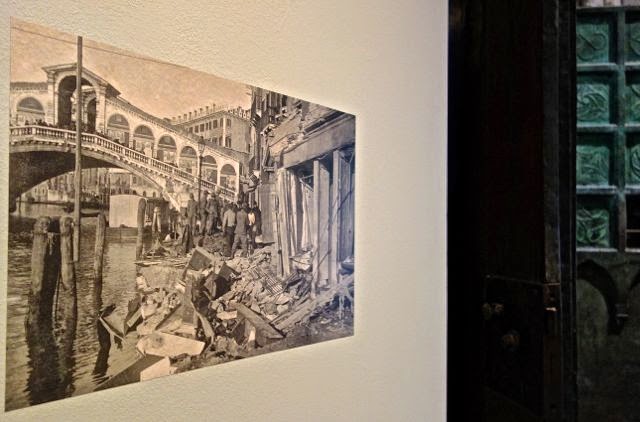photograph courtesy
Casa dei Tre Oci
Venice
– Giudecca: Casa dei Tre Oci - Building
a Nation – Venezia Si Difende exhibitions. At the Casa dei Tre Oci on the
Guidecca Island of Venice two photographic exhibitions open the autumn season.
Venezia Si Difende
1915-1918 and Lewis Hine - Building a Nation are both on show until 8
December.
Casa
dei Tre Oci: Lewis Hine – Building a Nation. Lewis Hine – Building a Nation is
curated by Enrica Vigano. The exhibition
brings together, for the first time, original works from the Rosenblum family collection
of New York. It is the largest archival
collection of vintage prints by Hine in private hands. Through a nucleus of sixty vintage prints his
most well known cycles are presented here: the famous workers of the Empire
State Building, the immigrants to Ellis Island, from the Pittsburgh reportage
to Child Labor in Pennsylvania, North Carolina and Virginia. We can admire the
mastery and humanity of the father of social photography and link to his
experience some of the highest values of the subsequent generation, represented
for example by the Photo League.
Above.
A trailer of the film America and Lewis Hine, by Nina Rosenblum and Daniel Allentuck,
Daedalus Production, on show in the exhibition.
Lewis
Hine, Riveters at Work on a Beam New York, 1931, from the series Empire State
Building.
photograph courtesy
Casa dei Tre Oci
Lewis
Hine – Building a Nation. Lewis Hine (1874-1940) was born in Oshkosh,
Wisconsin. He was a teacher and a sociologist at Columbia University, he
decided to embrace a camera to better represent social conditions: his photograph
built a nation. “Maybe you are fed up of images of child labor. Well we all
are.” said Hine. “But we aim to make you
and the whole country so uncomfortable before this question that when the time
comes to action, images of child labor will only no more a testimony of the
past.”
Above.
Portrait of Lewis Hine.
photograph courtesy
Casa dei Tre Oci
Lewis
Hine - Building a Nation. A mechanic with a micrometer measuring the drive
shaft he is building. 1920c.
Lewis
Hine – Building a Nation - Child Labor. Excavators in a coal mine in West Virginia
in 1908.
Lewis
Hine – Building a Nation. Young Child Picking Cotton, 1908 c. front and back.
photograph courtesy
Casa dei Tre Oci
Lewis
Hine – Building a Nation – Ellis Island. An Italian family in search of his
lost luggage New York, 1905.
Lewis
Hine – Made in America - Building a Nation Stamps. A tribute to Hine by the
United States Postal Service. The stamps,
bearing his photographs, were issued in August 2013, they honor the brave workers
who helped build the country.
Casa
dei Tre Oci
Photographs
courtesy - archivio Storico fotografico della fondazione Musei civici di
Venezia
Casa
dei Tre Oci: Venezia Si Difende 1915-1918. One hundred years after the
beginning of the First World War, the Venezia Si Difende 1915-1918 (Venice
Defends Itself 1915 – 1918) exhibition, until 8 December, is curated by Claudio
Franzini. It intends to describe the
city’s unusual situation at the time of the Great War and offers a
comprehensive panorama of the dramatic events, so as not to lose either their
historical perspective or that settled in our collective memory, by means of
more that 350 original photographs from the Fondazione Musei Civici di Venezia historic photographic archives housed at Palazzo Fortuny.
Above.
Basilica di San Marco, protection status of the church, gelatin print, 1916.
Photographs
courtesy - archivio Storico fotografico della fondazione Musei civici di
Venezia
Venezia
Si Difende 1915-1918. San Marco Bell Tower. The Sansovino loggia is covered and
protected with sandbags, gelatin
print, 1915.
Director of the Fondazione Musei Civici di
Venezia, Gabriella Belli and the curator of the exhibition, Claudio Franzini
Venezia
Si Difende 1915-1918. The historic photographic archives are housed at Palazzo
Fortuny.
Photographs
courtesy - archivio Storico fotografico della fondazione Musei civici di
Venezia
Venezia
Si Difende 1915-1918. The exhibition is divided into four
sections virtually not documenting acts of war but defensive strategies; the
complex task of preventive protection of the monuments with sandbags and
masonry reinforcements, the removal of precious art treasures, the
transformation of the turrets of the city into posts for sighting and air defense,
the balloons brakes that were raised to obstruct the airspace. Also illustrated are the difficulties of
everyday life: the blackout, shelters, hospitals, the removal of debris, and
the withdrawal of bank deposits. And, an important section is also devoted to the
effects of air attacks suffered.
Above. Soldiers on the lookout on railed rooftop platforms, gelatin print, 1915-1918.
Venezia
Si Difende 1915-1918 - The Rialto Bridge.
Photographs
courtesy - archivio Storico fotografico della fondazione Musei civici di
Venezia
Venezia
Si Difende 1915-1918. Particularly dramatic bombings of great emotional impact of
one of the masterpieces irretrievably lost, which caused a strong international
reaction: the ceiling fresco of the Church of the Scalzi with works by Giambattista
Tiepolo, was destroyed in an attempt to hit the nearest railway station.
Photographs
courtesy - archivio Storico fotografico della fondazione Musei civici di
Venezia
Venezia
Si Difende 1915-1918. 42 raids were dumped on the city, a
total of 1029 bombs (300 during the night between 26 and 27 February 1918), not
only with the result of causing substantial damage to property, but also 52
deaths and 84 wounded.
Venezia
Si Difende 1915-1918 - Piazza San Marco
Pin It





















